The Remarkable Miss Ella Gordon
The two horses pulling the farm wagon on which her coffin lay stepped out in time to the music of the Genadendal Brass Band, as she had taught them.
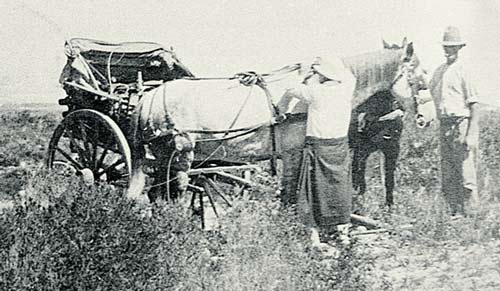
Picture: Miss Gordon and her driver with the cart in which she regularly drove to Hermanus for tea and scones.
Every morning she would go to each of her horses and say: “Give me a kiss”. She would inspect each one carefully, wipe their eyes, noses and wash under their tails with a washcloth.
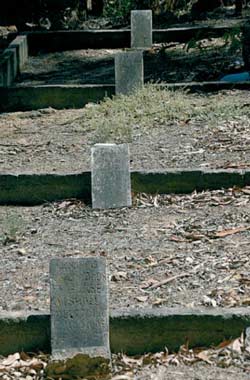 Then she would sing a tune and one of her horses would stamp his hooves in time with the music. She even interrupted a church service to have one of her horses, that died, buried in her own horses’ cemetery.
Then she would sing a tune and one of her horses would stamp his hooves in time with the music. She even interrupted a church service to have one of her horses, that died, buried in her own horses’ cemetery.
To those who knew her, Ella Gordon was an amazing, intelligent, very talented, good and kind-hearted woman and friend. To some she seemed strange. In Village of the Sea Arderne Tredgold wrote that, “Hermanus is used to odd characters... One of the most remarkable people to become a part of Hermanus was a sturdily-built woman with rosy cheeks and bright blue eyes, and with her hair pulled back severely into a bun [in later years she wore her hair cropped short], who used to come spanking into Hermanus driving a cart and horses.”
Picture: Fourteen horses are buried in the cemetery at Karwyders kraal (right). The wooden headstones Miss Gordon originally made for each grave have been replaced by ones of cement. The one in the foreground is for her “Wonder Horse”, Boysums.
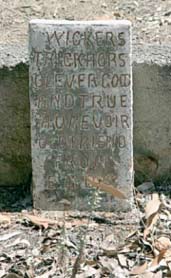 Picture: The headstone for Wickers – “Trick horse, clever, good and true”
Picture: The headstone for Wickers – “Trick horse, clever, good and true”
70-year-old Mr Pieter van der Bergh of Karwyderskraal in the Hemel-en- Aarde Valley near Hermanus, once stable groom to Miss Ella Gordon’s horses.
Almost all of the 60-odd Karwyders- kralers had a story about Ella Colston. Reportedly she was a member of the Black Sash, an anti-apartheid women’s movement. They recalled that “she kept an eagle eye on attendance at Sunday church services and absentees were summoned to the farmhouse to account for their tardiness. People found drinking on the farm were summarily evicted.”
EARLY YEARS
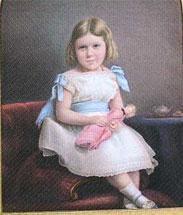 Isabella Gordon Dove Colston, born on 18 January 1873 in Edinburgh, Scotland, was the second child of James Colston and his wife, Isabella Dove. Her brother died shortly after birth. When Ella was seven years old, her mother died.
Isabella Gordon Dove Colston, born on 18 January 1873 in Edinburgh, Scotland, was the second child of James Colston and his wife, Isabella Dove. Her brother died shortly after birth. When Ella was seven years old, her mother died.
In 1881 the widower James Colston was living at 23 Regent’s Terrace, South Leith, Edinburgh with his daughter Ella, his mother, a cook and a house-and-table maid. According to the census of 1891 they were still living at the same address. Ella, then 18 years old, was “attending classes” and the family had two servants.
Picture: A child from a genteel background: this picture of Ella used to hang in her house on the farm.
After finishing her education at the St Giles Public School, where she also took music les- sons, Ella received private tuition at University level in drama, English, French, history and other subjects. Amongst the books she left behind were various book prizes for academic achievements in grammar, geography, English, elocution, Bible Class, history and pianoforte.
 James Colston, Ella’s father, was the younger son of Alexander Colston and Margaret Flockhart. His elder brother Alexander, a brilliant student and a writer on moral science, died at the age of 21. He also had two younger sisters, Joan and Margaret. Joan died when only two years old.
James Colston, Ella’s father, was the younger son of Alexander Colston and Margaret Flockhart. His elder brother Alexander, a brilliant student and a writer on moral science, died at the age of 21. He also had two younger sisters, Joan and Margaret. Joan died when only two years old.
After completing his schooling at the Royal High School, one of the best state schools, James joined his father and uncle in their printing business Colston & Son, in Edinburgh. When his father died in 1870 James became sole owner of the firm.
Although a printer by profession, James Colston was also an author and a public figure who “gave the city the best of his efforts and a large share of his time”. He served on many committees and was a magistrate for 32 years. His picture still hangs in the Magistrates’ Committee Room in the City Chambers.
When he died on 6 June 1897, Ella and her aunt were present. He was accorded a public funeral attended by the chief officials of the city, other dignitaries and many friends.
Part of his £4 712 estate was formed into a trust from which an annuity was to be paid to Ella’s aunt, and after her death, to “Ella Gordon Dove Colston during her natural life... I have made this provision because “I know the warmness and liberality of my daughter’s heart and her enthusiasm in any object in which she takes an interest ”, and so that she could not enter into possession of this fund and therefore “may never come to want during her lifetime”.
In 1903 when her aunt died, Ella, then residing in South Africa, was the residuary legatee of the whole of her estate to the value of £786.
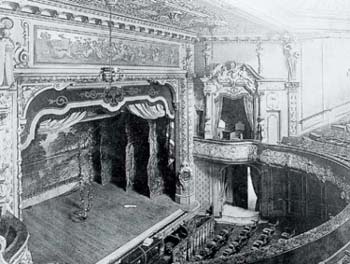 Picture: The Tivoli Music Hall in CapeTown, where Miss Gordon performed after she arrived in South Africa with her troupe from Europe
Picture: The Tivoli Music Hall in CapeTown, where Miss Gordon performed after she arrived in South Africa with her troupe from Europe
Ella Gordon Colston grew up in a time that came to be regarded as the heyday of music hall (comedy with music) and variety entertainment. Music halls were opened all over the world. By 1875 there were 375 in Greater London alone. Edin- burgh also boasted some, like the Moss Theatre of Varieties and The Grand Theatre, later the Tivoli Music Hall. Audiences were seated at tables, and food and drink was served throughout the performance, which took place on a platform at one end of the hall.
Singing and the comic song were at the heart of music hall, but gradually the acts increased in diversity and all sorts of ingenious and strange specialty acts developed. As its popularity increased, people became more interested in the entertainment than the food and drink. By the end of the 19th century there could be as many as 20 acts per show and performances lasted up to four hours.
Women increasingly became the main performers and actors, also playing the male roles. Top stars could earn big money and players were contracted for a period of time, rather than by performance.
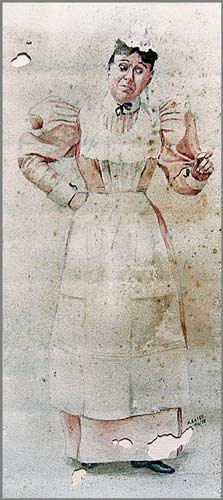 Picture: A sketch dated 1898 of Miss Gordon in theatrical costume.
Picture: A sketch dated 1898 of Miss Gordon in theatrical costume.
Sometime between 1893 and 1897, Ella Colston became involved in these variety shows. Her musical abilities, deep voice and talent for acting secured her a place, often playing the role of a man. One of these, presumably, was the role of an unlikely World War I hero who immigrates to America to find his pen-pal sweetheart.
Posing as a vaudeville strongman, Zandow, his love- struck odyssey spins through a series of increasingly audacious comedy set pieces. (A picture of Ella as the supposed Zandow, The Strong Man, hung in her house at Karwyderskraal.)
Shortly after her father’s death she went on tour first to France and from there to South Africa with her troupe. They per- formed at the Tivoli Music Hall on the Corner of Plein and Darling Street in Cape Town. Unfortunately, with South Africa in the throes of a war, entertainment circuits were suffering a depression and between 1899 and 1904 many overseas artists were stranded here. Ella Colston was one of them.
For a time she stayed on in Cape Town and continued taking part in plays and variety shows at the Tivoli.
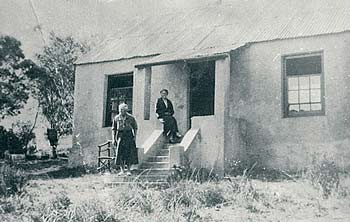 Here in Cape Town she met Miss Clara Marie Markgraff, who had once been music teacher to the family of Kaiser Wilhelm II.
Here in Cape Town she met Miss Clara Marie Markgraff, who had once been music teacher to the family of Kaiser Wilhelm II.
Picture: Ella and Clara in later years, probably at Karwyderskraal
She was the aunt of Rev P W Schaberg, and it must have been through them that she became interested in the farm Braemar in the Hemel-en-Aarde Valley, which had once belonged to the Moravian Mission who used to run an institute for lepers there. In 1846 the leper colony was transferred to Robben Island by Lord Charles Somerset, the Governor at he Cape, and the land was subdivided into four parts. When Ella decided to stay and settle in rural South Africa, she bought in 1900 for £487 a two thirds share of Braemar, where the Hamilton Russell vineyards are today.
The city born and bred actress Isabella Colston dressed herself in khakis and became Ella Gordon the farmer.
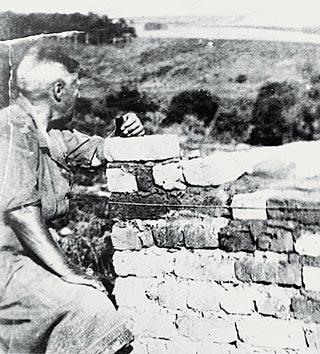 Picture: Miss Gordon, hair typically cropped short, busy building.
Picture: Miss Gordon, hair typically cropped short, busy building.
She was hard-working and did almost everything herself, from ploughing, planting and harvesting, to carting bags of grain to Caledon, Genadendal and Cape Town. She also milked her cow and cared for her horses and dogs.
Although short of stature, she was strong and independent and would not accept help from anyone loading or off-loading bags weighing 90 kg each. (The hard labour took its toll in her later life, as she developed a pronounced stoop.) Travellers going past her farm often stood staring at her, sometimes even making rude remarks. To them a woman wearing trousers, busy farming, doing everything herself with cob pipe in mouth, was very strange.
Eventually she sold Braemar and settled on the more remote Karwyderskraal, which she bought in 1910 from a Mr Le Roux.
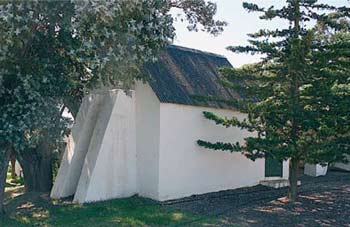 Picture: The first house that Miss Gordon built in South Africa, on the farm Braemar in the HemelenAarde Valley. It now forms part of the farm manager’s home at HamiltonRussell Vineyards
Picture: The first house that Miss Gordon built in South Africa, on the farm Braemar in the HemelenAarde Valley. It now forms part of the farm manager’s home at HamiltonRussell Vineyards
With one helper, Ella built her own houses at both farms with clay bricks she made herself. The little house at Braemar, with its buttresses and low doorways, is somewhat quaint and in places askew. The one at Karwyderskraal was bigger, and in later years she added more rooms and moved the entrance. A good carpenter, she made most of the furniture, built-in bookcases, doors and windows herself. On the panels of some of the doors she painted beautiful scenes. Mr Anthony Hamilton Russell has rescued a cabinet with a Scottish and a German crest individually carved on the panels.
 Picture: The front door of Miss Gordon’s badly neglected house at Karwyderskraal as it looks today. Miss Gordon added this entrance and porch when she extended the house from its original singlepitch construction. The modest gable bears her initials.
Picture: The front door of Miss Gordon’s badly neglected house at Karwyderskraal as it looks today. Miss Gordon added this entrance and porch when she extended the house from its original singlepitch construction. The modest gable bears her initials.
At Karwyderskraal she also built, amongst others, a church and a school for Coloured people. Rev Schaberg helped to get the school registered with the Government and in October 1950 the “Gordon Primary School” was opened with 23 pupils, and Mrs Beatrice Nasson of Caledon appointed as teacher. During the week Mrs Nasson stayed in Miss Ella’s house. Miss Gordon extended one of her tenant’s houses by add- ing two rooms, one for girls and one for boys, to serve as a hostel.  She made sure that the children were properly fed, many of the vegetables coming from her own garden. She was, unusual for her time, a vegetarian and used olive oil for cooking.
She made sure that the children were properly fed, many of the vegetables coming from her own garden. She was, unusual for her time, a vegetarian and used olive oil for cooking.
Like everything else she did, Miss Gordon farmed with gusto, but theatre was still in her blood. She trained her horses and taught them all kinds of tricks. One of them, a white horse called Boysums, had a remarkable repertoire of tricks. He could pick out blocks marked with the letters of his name, all jumbled up, and hang them by rope loops on pegs in the correct order. If two figures, for example eight and seven, were put in front of him, he would paw eight times with one hoof and seven with the other. He could also dance to music. His headstone in the horses’ cemetery reads: “Boysums, the Wonder Horse. We shall meet to part no more. R.I.P.”
Picture: a wardrobe she made herself, photographed in her room.
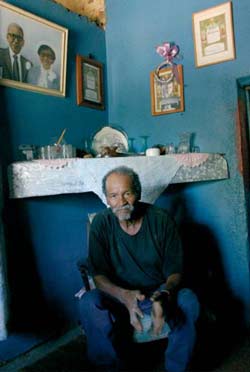 Picture: Pieter van der Bergh, at times groom to Miss Gordon’s horses, describes the morning routine in the stables. The portrait at top left on the wall is of his mother and father, who in Miss Gordon’s will were instructed to stay on in her house and care for her dog.
Picture: Pieter van der Bergh, at times groom to Miss Gordon’s horses, describes the morning routine in the stables. The portrait at top left on the wall is of his mother and father, who in Miss Gordon’s will were instructed to stay on in her house and care for her dog.
Visitors sometimes found it disconcerting when a hat that had been put beside a chair was picked up and hung on a peg by a horse. Mr Pieter van der Bergh recalls that one of her horses could even put a letter into a post box.
Her musical and acting abilities were used to put on various school concerts, teaching the children to sing and dance. She also staged theatrical productions for charity. The older people in Genadendal still fondly remember and talk about Miss Ella’s concerts, says Rev Maarten Wessels. In 1918, The King’s Cup, “a thrilling and romantic drama”, was presented by the Caledon A D Society “under her personal management and direction” in the hall of the Conservatorium at Stellenbosch. The incidental music was provided by Mrs J J Moore on the violin, Mrs G Smuts on the piano and Miss Clara Markgraff on the cello. It was the biggest production the Dramatic Society had undertaken to date.
Miss Markgraff had retired to Caledon, where they met again and started visiting. Rev Schaberg, who knew both ladies well, said “...they were on equal footing and became lifelong friends. They used to joke a lot with each other. And, with a two-horse-cart, made many trips in South Africa”. Clara later went to live with Miss Gordon at her farm and managed “the household and meals in spite of her impractical ways”.
 Picture: One of a number of doors in her house on which Miss Gordon painted artistic scenes, some from Japan, others from Egypt. She also made all the doors, windows and cupboards herself.
Picture: One of a number of doors in her house on which Miss Gordon painted artistic scenes, some from Japan, others from Egypt. She also made all the doors, windows and cupboards herself.
One morning they cleared their stove and poured the still hot ashes near the fence. Suddenly a fire alighted the surroundings and ran along the mountain until a brook stopped it. The people of Hermanus were very upset, but not much dam- age was done.
A train accident in which Miss Markgraff and others were involved on Sir Lowry’s Pass, brought them some money. They bought a small plot on the mountainside in Hermanus and built a holiday house, which Clara named Kis- met. The house at 38 Eleventh Avenue, Voëlklip, although greatly altered, is still standing. Clara later moved to Genadendal where she died and was buried in 1940.
Until the motor traffic became too much for her horses, Miss Ella would regularly call at the Kraal Rock tea garden in Hermanus for tea and scones, followed by an ice-cream. Tea and scones was also always sent out to her driver. Ella and old Mr Lumsden, whose daughters ran the tea garden, would sit and talk about the old days in their homeland, Scotland. When she left she always asked for a packet of Russian toffee, the Scottish name for fudge.
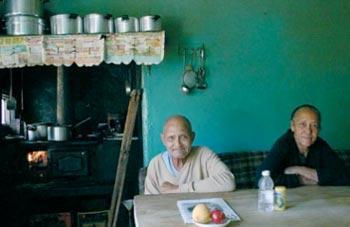 Picture: Edward and Angeline Kapot still live in the house his father built at his own expense at Karwyderskraal.
Picture: Edward and Angeline Kapot still live in the house his father built at his own expense at Karwyderskraal.
Miss Ella Gordon died in 1958. Rev Schaberg was in Germany at the time and the funeral service was performed by some- one else. The two horses pulling the farm wagon on which her coffin laid stepped out in time to the music of the Genadendal Brass Band, as she had taught them.
Isabella Gordon Dove Colston was laid to rest as requested “in the smaller cemetery on the farm Karwyderskraal”, next to her horses and her dog, Woppy. Her grave is still there, but little of her legacy remains.
On Saturday, 28 June 1958,
the Hermanus News reported that a “remarkable old character in the person of Miss Ella Gordon - Dove Colston, passed away recently at Hermanus, at the age of 85. Up to the time of her death she was apparently strong and healthy, and preferred to live alone. Few people knew her full name: to most she was ‘Miss Gordon’. A hard worker all her life, she accumulated an estate worth £12,669, as was proved in her will, which was filed last week... Miss Gordon was extremely fond of animals, particularly horses and dogs...
At her direction, she herself was laid to rest last month near the animals’ cemetery on this farm [Karwyderskraal]... She further directed in her will that her remaining two horses and her dog were to be buried and tombstones erected in the animal cemetery, after they have been cared for on the farm during the remainder of their lifetime. Once a fortnight, also, they will be given 1s. 6d. worth of sweets or sugar sticks, as she had always done...” and during bad weather they had to be kept in their stables.
Ella Gordon's Will

She had houses built for the Coloured people who worked for her and did much to uplift them. In her will she also made provision for them – To some she left money.
Andreas and Anna van der Bergh could stay on in her house and Anna had to look after her dog, Blom. He had to be brushed regularly and be given his regular food and milk and be allowed to sleep in his usual place in the house. She also had to pay the annual dog license. Her linen, clothes, shoes and blankets she left to Anna.
Karel Alberts received £10 and her guitar.
Mr Rosant - Her violin, gramophone, records, sheet music and “any other musical instrument which I may possess at the date of my death”, together with her rifle, guns and revolvers, she left to Rev P W Schaberg.
Her books, almost all hardbacks, some in whole or part leather-bound. Amongst them were books by authors such as Sir Walter Scott, Charles Kingsley, Shakespeare and Thoreau, also the Diary of a Cape Housekeeper by Hildagonda Duckett, which was well used, especially the section on puddings! There were also two sets of encyclopaedias, many plays, poetry books, novels, scientific books, language manuals, books on agriculture, horse-breeding, dogs, fencing, boxing, a Bible in Gaelic and many religious books. She also had acquired many second-hand books from the American Novelty Store in Caledon.
Moravian Church of South Africa (Western Province) - The chief beneficiary of her will was the, Moravian Church of South Africa (Western Province) of which Rev P W Schaberg, nephew of her friend Miss Clara Markgraff, was then Bishop. He was also requested to perform the funeral service. She bequeathed the Church her farm Karwyderskraal with all the implements, under certain conditions: her tenants and labourers had to keep their homes; money earned from the land had to be used to improve the farm; fertilizers and bags for their crops had to be given to the three tenant farmers; the Church may on no account sell the farm; her furniture in the house must not be sold, and everything had to remain just as it was then. Mr Edward Kapot had to be allowed to occupy the house which he had built at his own expense and only to pay the municipal rates. Everything else she left to the said Church “to be used by them for whatsoever purpose they may in their discretion determine”.
MORAVIAN CHURCH – ELLA GORDON MONEY LEGACY:
With the money Ella Gordon left, the Church built two new school rooms which conformed to government specifications and the old school and church were changed into hostels for boys and girls from distant farms. A small “mission station” began to flourish. (This was earlier the plan of three Moravian teachers who had bought Karwyderskraal in 1902 to provide a home for farm workers, but their venture proved uneconomical and the farm was returned to its original owner.)
The Church also fenced Karwyderskraal, bought new implements and built an agricultural college with main house, barn and dairy. At that stage Coloured people could not yet own their own farms, and as it was felt that the Church was only providing training for people to be farm labourers and not farmers in their own right, the work was discontinued. In 2003 the main house, barn and dairy were restored at a cost of R180 000. These buildings are now rented
by Ulrike Christensen, a cheese maker, who also employs and trains people. Part of the rest of the farm is leased to a contractor who is busy clearing all the alien trees and plants to eventually re-establish the natural fynbos and to plant buchu for sustainable harvesting. Part of his contract is the upkeep of the fire belt and fences. Through the leasing of the farm money is generated which also enables the Church to let the descendants of Miss Ella’s tenants and labourers stay in their houses at a minimal rental fee. One of the lessees brought electricity to the farm.
Miss Gordon’s house has fallen into a state of neglect and tenants over the years have sold off much of her furniture, books, pictures and personal belongings. Fortu- nately the Church removed some of it for safekeeping at the Genadendal Museum. The farm implements were used on the farm until they had to be written off.
Source
Story, Information, Photos and images written and supplied by Annalize Mouton, Village Life No 11 • April/May 2005
Call us and schedule your listing today! Contact Us
Copyright © 2025 Hermanus Online Magazine. Web Development by Jaydee media.
